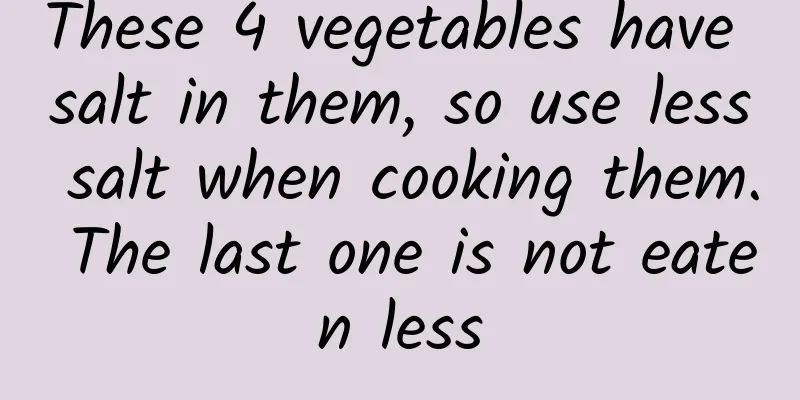These 4 vegetables have salt in them, so use less salt when cooking them. The last one is not eaten less

|
When it comes to vegetables, everyone thinks they are "especially light" and when cooking, everyone treats them equally, adding salt as much as possible, otherwise there will be no taste. Especially when the older generation cooks vegetable dishes, they always add a lot of salt to season them, as they believe that vegetables have no taste to begin with and will taste even less tasty if they are bland. However, among the common vegetables on the table, there are 4 special ones. They are naturally salty, so you need to add less salt when cooking. Chrysanthemum chrysanthemum (No. 4) Sodium content: 161.3 mg/100 g[1] Chrysanthemum chrysanthemum is also called chrysanthemum vegetable. It has a unique flavor. It can be used in hot pot, stir-fry or soup. However, remember to use less salt! Its sodium content is relatively high among common leafy vegetables, almost ten times that of lettuce (leaf lettuce 16.1 mg/100g). Although the sodium content is higher than that of lettuce, the carotene content is 58 times that of lettuce. For students and office workers who use their eyes frequently, eating more Chinese spinach is helpful for eye protection. Chinese cabbage (third place) Sodium content: 170.2 mg/100 g[1] Unexpectedly, right? The popular Chinese cabbage has a high sodium content, a little higher than Chinese chrysanthemum. However, despite the high sodium content, the nutrition of cabbage is still very pleasing. Its vitamin C content is higher than that of oranges we usually eat. The vitamin C content of cabbage is 37.4mg/100g, while the vitamin C content of oranges is 33mg/100g. Eating raw cabbage can supplement vitamins in a similar way to oranges, but this advantage is lost when cooked, as the vitamin C is lost when heated. According to EU data, the loss rate of vitamin C in boiled vegetables is 60% to 70%[2]. If the vegetables are blanched for a short time, the loss is not too much. Fennel (second place) Sodium content: 186.3 mg/100 g[1] Fennel is also one of the vegetables with a unique flavor, and many people cannot accept its "fragrance". Fennel is most commonly used to make dumplings stuffed with fennel, and when people make dumplings, they often add a lot of salt to make them more flavorful. In fact, it is not necessary. First of all, the sodium content of fennel itself is not low. Adding too much salt can easily lead to excessive salt intake. Secondly, if you add less salt to make dumplings, even if they taste bland, you can use dipping sauce to make up for it. But if the filling is salty, there is no way to make up for it. You can't just rinse the dumpling filling before eating it. In addition to its unique taste, fennel also has another nutritional advantage, which is that it has a relatively high calcium content, which is 1.5 times the calcium content in milk (107mg/100g). The oxalic acid content is not high, and the absorption rate is also acceptable. Eating 200g of fennel and drinking a 250ml bag of milk every day can supplement 70% of the daily calcium requirement. Celery (No. 1) Sodium content: 313.3 mg/100 g[1] This sodium content is quite high among common vegetables, almost catching up with 1g of table salt (400mg of sodium is equivalent to 1g of table salt). Although celery has a high sodium content, it still has an advantage in dietary fiber. The dietary fiber of celery is 0.8 times higher than that of the banana we are familiar with. The dietary fiber of banana is 1.2mg/100g, while that of celery is 2.2mg/100g. For people who usually suffer from habitual constipation, you can add some celery to your daily dishes and pay attention to drinking more water, which will help relieve constipation. To sum up: the sodium content of the above four vegetables is not too low and they are naturally "salty". Therefore, when eating these vegetables, be sure to use less salt! Especially for people with chronic diseases, such as obesity, high blood pressure, and kidney disease, you should pay more attention. References: [1]. Yang Yuexin. Chinese Nutrition Composition Table 6th Edition. Volume 1[M]. Peking University Medical Press: Beijing, 2019. [2]. Yang Yuexin, Ge Keyou. Encyclopedia of Chinese Nutrition Science[M]. People's Medical Publishing House: Beijing, 2019: 82. Chinese Nutrition Society Note: This article was first published on the "Science Rumor Refutation" platform |
<<: To make matters worse, why is Sange so miserable?
Recommend
Can I drink alcohol when I'm pregnant?
You cannot drink alcohol when you are just pregna...
Is it good or bad to have blood clots during menstruation?
Every woman has a different physique, so she will...
High-dose low-frequency or low-dose high-frequency, which method of using recombinant human erythropoietin do you choose?
Erythropoietin is an active glycoprotein secreted...
Eating this dish for a week can cause gastrointestinal bleeding! This springtime delicacy is delicious, but these types of people should be careful
Speaking of spring, it always makes people happy....
People who snore when sleeping, beware of 8 major hazards! Huaxi experts: Don't believe in drug treatment, what really works is...
Many people have had this experience. Sleeping wi...
How to use short-acting contraceptive pills
Birth control pills have become one of the most e...
Scary! In just two hours, the microplastics we eat can enter our brain!
Plastic fragments with a diameter of less than 5 ...
How big is the yolk sac?
The yolk sac appears in many women after they bec...
Can I take a bath during confinement?
Generally, women may encounter the question of wh...
To remove or not to remove tonsils? The debate over whether to remove or not tonsils
There is an organ in our body that has different ...
Why do you need a blood test for early pregnancy?
Early pregnancy blood test is known to all female...
Can I hold my baby during confinement?
During the confinement period, many mothers like ...
The second trimester is a change from week to week
In daily life, with more and more pregnant women ...
What causes bleeding in the third trimester of pregnancy?
People usually give up their seats when they see ...
What are the symptoms of uterine tumors in women?
There are many physical discomforts after uterine...









